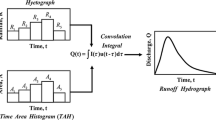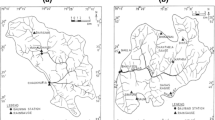Abstract
The predictability of unit hydrograph (UH) models that are based on the concepts of land morphology and isochrones to generate direct runoff hydrograph (DRH) were evaluated in this paper. The intention of this study was to evaluate the models for accurate runoff prediction from ungauged watershed using the ArcGIS® tool. Three models such as exponential distributed geomorphologic instantaneous unit hydrograph (ED-GIUH) model, GIUH based Clark model, and spatially distributed unit hydrograph (SDUH) model, were used to generate the DRHs for the St. Esprit watershed, Quebec, Canada. Predictability of these models was evaluated by comparing the generated DRHs versus the observed DRH at the watershed outlet. The model input data, including natural drainage network and Horton's morphological parameters (e.g. isochrone and instantaneous unit hydrograph), were prepared using a watershed morphological estimation tool (WMET) on ArcGIS® platform. The isochrone feature class was generated in ArcGIS® using the time of concentration concepts for overland and channel flow and the instantaneous unit hydrograph was generated using the Clark's reservoir routing and S-hydrograph methods. An accounting procedure was used to estimate UH and DRHs from rainfall events of the watershed. The variable slope method and phi-index method were used for base flow separation and rainfall excess estimation, respectively. It was revealed that the ED-GIUH models performed better for prediction of DRHs for short duration (≤6 h) storm events more accurately (prediction error as low as 4.6–22.8%) for the study watershed, than the GIUH and SDUH models. Thus, facilitated by using ArcGIS®, the ED-GIUH model could be used as a potential tool to predict DRHs for ungauged watersheds that have similar geomorphology as that of the St. Esprit watershed.
Similar content being viewed by others
References
Chow VT, Maidment DR, Mays LW (1988) Applied hydrology. McGraw-Hill Company, NY
Clark CO (1945) Storage and the unit hydrograph. Trans. ASCE 110:1419–1446
HEC (2000) Hydrologic engineering center HEC-HMS user's manual. Davis, California
Garg V, Chaubey BE, Haggard BE (2003) Impact of calibration watershed on ruoff model accuracy. Trans. ASAE 46(5):1347–1353
Gupta VK, Wymire ED, Wang CT (1980) A Representation of an Instantaneous Unit Hydrograph from Geomorphology. Water Resour Res 16(5):855–862
Horton R (1945) Erosional development of streams and their drainage basin: hydrophysical approach to quantitative morphology. Geol Soc Am Bull 56:275–370
Jain SK, Chowdhry H, Seth SM, Nema RK (1997) Flood estimation using a GIUH based on a conceptual rainfall-runoff model and GIS. ITC J 1997-1:20–25
Jain SK, Singh RD, Seth SM (2000) Design flood estimation using GIS supported GIUH approach. Water Resour Manage 14:369–376
Jain V, Sinha R (2003) Derivation of unit hydrograph from GIUH analysis for a Himalayan river. Water Resour Manage 17:355–375
Kirpich ZP (1940) Time of concentration of small agricultural watersheds. Civil Eng 10:362–368
Kumar R, Chatterjee AK, Lohani AK, Kumar S, Singh RD (2002) Sensitivity analysis of the GIUH based Clark model for a catchments. Water Resour Manage 16:263–278
Lapp P, Madramootoo CA, Enright P, Papineau F, Perrone J (1998) Water quality of an intensive agricultural watershed in Quebec. J Am Water Resour Assoc 34(2):427–437
Lee KT (1988) Generating design hydrographs by DEM assisted geomorphologic runoff simulation: A case study. J Am Water Resour Assoc 34(2):375–384
Lee MT, Blank D, Dellur JW (1972) A program for estimating runoff from Indiana watersheds, Part II. Assembly of hydrologic and geomorphologic data for small watersheds in Indiana. Tech Rep. No. 23, Purdue University, Water Resources Research Centre, Lafayette, Indiana
Maidment DR (1993) Developing a spatially distributed unit hydrograph by using GIS, In: Application of geographic information systems in hydrology and water resources management, IAHS Publication No. 211. IAHS Press, Institute of Hydrology, Wallingford, UK, pp 181–192
Martinez V, Garcia AI, Ayuga F (2001) Distributed routing techniques developed on GIS for generating synthetic unit hydrograph. Trans ASAE 45(6):1825–1834
McCuen R (1997) Hydrologic analysis and design, 2nd edn. Prentice-Hall, NJ
Muzik I (1996) Flood modeling with GIS-derived distributed unit hydrograph. Hydrol Process 10:1401–1409
Ritter DF, Kochel RC, Miller JR (2002) Process geomorphology. Mc Graw Hill, Boston
Rodriguez-Iturbe I, Valdes J (1979) The geomorphological structure of hydrologic response. Water Resour Res 15(6):1409–1420
Rodriguez-Iturbe I, Gonzalez-Sanabria M, Bras R (1982) A geomorphoclimatic theory of the instantaneous unit hydrograph. Water Resour Res 18(4):877–886
Rodriguez-Iturbe I, Rinaldo A (1997) Fractal river basins. Cambridge University Press, UK
Romero D, Madramootoo CA, Enright P (2002) Modelling the Hydrology of an Agricultural Watershed in Quebec using SLURP. Canadian Biosyst Eng 44:1.11:1.20
Sarangi A, Madramootoo CA, Enright P, Prahser SO, Patel RM (2005) Performance evaluation of ANN and geomorphology-based models for runoff and sediment yield prediction for a Canadian watershed. Curr Sci 89(12):2022–2033
Sarangi A, Madramootoo CA, Singh DK (2004) Development of ArcGIS assisted user interfaces for estimation of watershed morphologic parameters. J Soil Water Conserv 3(3/4):139–149
Singh VP (1988) Hydrologic Systems: Rainfall-runoff modeling, vol. 1. Englewood Cliffs, Prentice Hall, NJ
Smart J (1972) Channel networks. Adv Hydrosci 8:305–346
Sorman AU (1995) Estimation of peak discharge using GIUH model in Saudi Arabia. J Water Resour Plann Manage 121(4):287–293
Strahler AN (1957) Quantitative Analysis of Watershed Geomorphology. Trans Am Geophysic Union 38(6):913–920
Wang C, Gupta V, Waymire E (1981) A geomorphologic synthesis of non-linearality in surface runoff. Water Resour Res 17:545–554
Zhang B, Govindaraju R (2003) Geomorphology-based artificial neural networks (GANNs) for estimation of direct runoff over watersheds. J Hydrol 273:18–34
Author information
Authors and Affiliations
Corresponding author
Rights and permissions
About this article
Cite this article
Sarangi, A., Madramootoo, C.A., Enright, P. et al. Evaluation of three unit hydrograph models to predict the surface runoff from a Canadian watershed. Water Resour Manage 21, 1127–1143 (2007). https://doi.org/10.1007/s11269-006-9072-9
Received:
Accepted:
Published:
Issue Date:
DOI: https://doi.org/10.1007/s11269-006-9072-9




